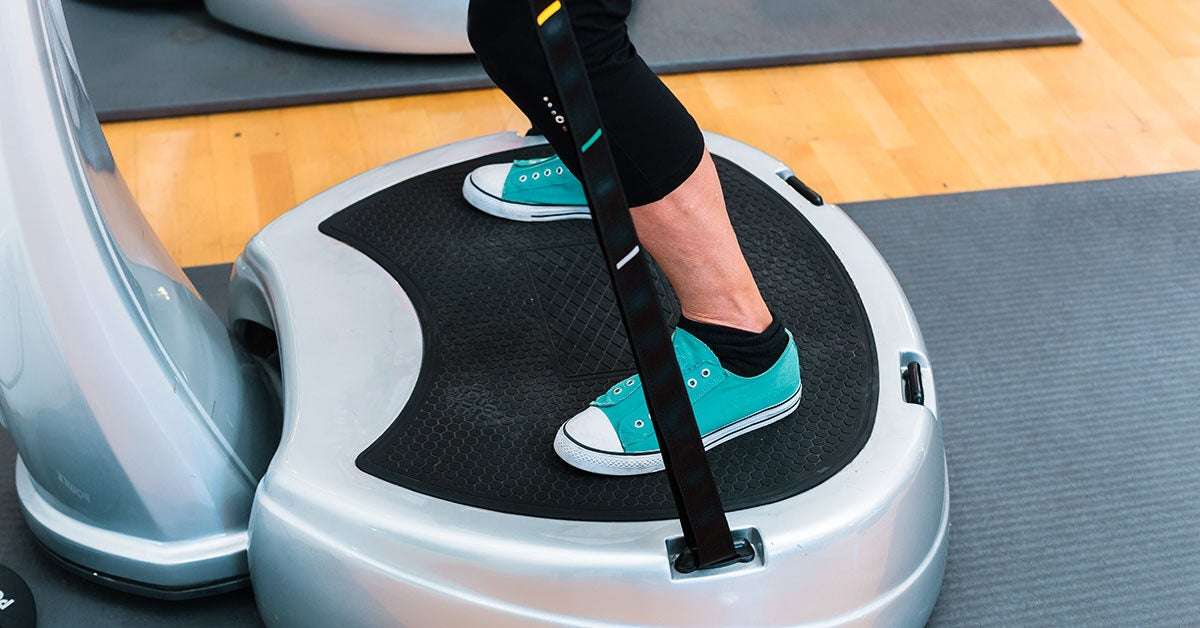
Share on Pinterest
Kzenon/Shutterstock
Not to be confused with vibration belts that focus on weight loss, vibration plates are gaining traction as a therapeutic tool.
With the realization that astronauts were experiencing bone loss while in space for longer periods, scientists began to experiment with vibration therapy. Standing on an oscillating plate for at least 10 minutes a day resulted in bone loss regained.
These results have initiated numerous studies to find out if vibration therapy is a viable option for individuals with osteoporosis.
What is vibration therapy?
Vibration therapy enables muscles to contract and relax dozens of times per second through mechanical vibrations delivered by standing or lying on an oscillating platform.
Muscle contractions, due to their attachment to bone, inherently place stress (good stress) on the bone, forcing it to respond and grow.
History of vibration therapy
Vibration therapy has an extensive history dating back to ancient Greece.
In the 1800s, a type of vibration therapy was developed for Parkinson’s disease that inspired further study into the early 20th century. In has since been used in neurological studies, such as those involving cerebral palsy, and eventually for elite athletes and astronauts.
Types of vibration therapy
There are 2 main types of vibration therapy — whole body vibration (WBV) and low intensity vibration (LIV). Local muscle vibration (LMV) has also been used and studied.
WBV machines, like PowerPlate, are typically seen in gyms and fitness studios. These machines can create a range of intensity.
Intensity is measured by the amplitude (height) and speed (frequency) of the vibration.
LIV machines tend to look like bathroom scales and send tiny vibrations upward from the feet and up to the lower spine. The force you experience on these machines is less aggressive than what’s provided by WBV machines.
Does vibration therapy help with osteoporosis?
Research is ongoing, but studies have shown mixed results on the use of vibration therapy for osteoporosis. Whereas some research shows significant change for bone mineral density in mature persons, other research shows no change at all.
Fall prevention is especially important for those with osteoporosis. According to the Centers for Disease Control and Prevention (CDC), falls are the leading cause of death for those over age 65.
As mentioned previously, positive outcomes of vibration therapy have been noted for improving balance and preventing falls in older adults.
Researchers debate factors such as how progressed a diagnosis of osteoporosis is, the level of intensity, whether WBV or LIV is more suitable, and how long treatments should last.
The most promising and consistent results about vibration therapy for osteoporosis stem from LIV.
Still, most research concludes that vibration therapy will slow the progression of osteoporosis-related bone deterioration, even if it doesn’t improve bone mineral density.
Osteoporosis
Osteoporosis causes bones to weaken, making them fragile and brittle. This fragility can result in fractures with life altering — and even life threatening — outcomes.
Although osteoporosis primarily affects those over age 50, certain medications, lifestyle habits, or medical conditions can be precursors.
It’s important to start healthy bone building habits from a young age. Regular quality exercise, optimal nutrition, and meeting vitamin D needs are beneficial.
Risk factors for osteoporosis include:
- excessive alcohol or smoking
- lack of physical activity resulting in muscle & bone loss
- insufficient vitamin D
- some cancer treatments, steroids
- hyperthyroidism or hypothyroidism
- diabetes
- early menopause
- family history
Are vibration plates safe for osteoporosis?
Talking with your doctor is highly recommended before starting vibration therapy. Certain types of vibration therapy, the frequency used, and the amplitude of the vibrations should all be carefully considered when using vibration therapy for aging or brittle bones.
Most research supports LIV for osteoporosis meaning that vibration plates at the gym or studio are most likely too aggressive.
Therefore, it’s best to consult with your medical team and decide on a course of treatment that would likely take place under the watchful eye of a physical therapist.
The bottom line
Weight bearing exercise, adequate vitamin D, and a well-balanced diet are some factors that help maintain bone health. Vibration therapy has many benefits and may also help prevent the deterioration of bone, which is useful in the prevention of osteoporosis.
Vibration therapy may be a viable adjunct treatment option for those living with osteoporosis, especially in when it comes to maintaining balance, increasing muscle mass, and preventing falls. Still, the research is inconclusive regarding whether vibration therapy can increase bone density over time.
If you are curious about vibration treatment, talk with your medical care team. They can help you with assessing your unique health profile and the potential benefits of vibration therapy.
Whole-body vibration therapy (WBVT) may have many health benefits, including strengthening muscle and bone. This could potentially help people with osteoporosis to alleviate certain symptoms.
Vibration is essential to the body. It is associated with functions such as heart rate, the digestive system, lung movement, and the activity of the circulatory and lymphatic systems. Activities such as walking, sports, and some occupations transmit mechanical vibration to the body, which helps create stressors that strengthen muscles and bones.
Osteoporosis occurs when the structural integrity of bone weakens, allowing it to fracture more easily. It is often associated with age but can also be related to medical conditions. WBVT may benefit people with osteoporosis as it can help strengthen muscle and bone.
This article examines the process of whole-body vibration and how it affects osteoporosis. We also discuss different forms of vibration therapy and the potential risks.
Overview

Share on Pinterest
Somkhana Chadpakdee/EyeEm/Getty Images
According to the National Institute on Aging (NIA), osteoporosis is a disease that often occurs with age. It could lead to a decrease in physical activity as a person may fear breaking a bone.
The inner bone has a honeycomb-like appearance. With osteoporosis, the spaces between bone increase, and the walls of the bone become thin, allowing for easier breakage. Osteoporosis can affect anyone. However, the NIA states that females, particularly white and of Asian descent, are more likely to develop it. Menopause also accelerates the loss of bone mass, which can contribute to osteoporosis.
For everyone, bone growth slows after age 30, and by ages 40–50, bone loss may outpace bone replenishment.
Weight-bearing exercises may help promote bone growth, such as:
- weight training
- walking
- hiking
- tennis
- stair climbing
Learn more about osteoporosis here.
What is whole-body vibration therapy?
Scientists developed WBVT as an offshoot of a space program’s efforts to help astronauts avoid bone loss during space travel. They found that standing on a vibrating plate for 10–20 minutes each day helped astronauts regain the 1–2% bone loss they experienced from months spent in space stations.
During WBVT, a person stands or lays on a large vibrating platform with a handrail. The intensity of the vibration is adjustable, and the machine delivers vibrations to the person’s body at the rate of dozens of times each second.
WBVT may help build muscle in addition to bone and improve balance and mobility.
Can it help with osteoporosis?
A literature review shows mixed study results regarding human trials of WBVT.
One study tested 70 people postmenopause with two 10-minute sessions of WBVT each day for 1 year. Most participants lost bone mass in that time, but those weighing less than 143 pounds increased bone mass density by 3.3%.
Another study in people after menopause tested 86 individuals for 6 months, utilizing 10-minute sessions five times per week. Bone mass density increased by 4.3% after treatment compared to a control group.
An analysis of 25 studies concluded that there were small but significant improvements in balance and gait speed among older adults after WBVT.
Can it help improve bone density?
It is unclear whether WBVT helps improve bone density in people with osteoporosis.
However, alongside improving balance and gait speed in older adults, studies indicate that WBVT is effective in improving walking performance in people with knee osteoarthritis.
How whole-body vibration therapy works
The body naturally produces and absorbs vibrations daily through environmental and physiologic factors. These vibrations cause muscles to contract and expand, leading to stress on the attaching bones. This stress prompts a response from the bone, which promotes growth.
During WBVT, an individual stands on a plate that vibrates dozens of times per second. The machine has handrails to hold onto for comfort. Muscles contract and expand in response to the vibration and indirectly places mild stress on the bones.
Individuals with osteoporosis often reduce activity out of fear of breaking a bone. WBVT provides a low impact way to prompt bones to grow and strengthen.
Types of vibration therapy
There are two types of vibration therapy available: whole-body vibration and low intensity vibration.
A person stands on a platform that delivers the vibration to the entire body with whole-body vibration. A range of intensity and programs are usually available on the machine.
During low intensity vibration, the intensity level of the vibration lessens to only travel as high as the hips and lower spine. This therapy is generally for treating the lower body.
Risks
Overall, experts consider WBVT to be safe. However, people cannot use WBVT if they:
- have had any current or recent blood clots
- have a pacemaker
- are pregnant
- experience dizziness or inner ear issues
Outlook
WBVT is a promising therapy for people with osteoporosis. However, researchers need to complete more investigations, and the long-term outcomes are still unknown.
A person considering WBVT should consult a healthcare professional on its suitability and frequency of sessions.
Summary
Osteoporosis is a common condition that occurs as people age, particularly postmenopause. Some people may try WBVT to reduce bone loss, which may have promising results.
During WBVT, an individual will stand on metal plates that vibrate dozens of times each second. They can adjust the intensity and speed, and most machines provide handrails for support. These rapid oscillations stress the muscles and bones, promoting bone regeneration and growth.



